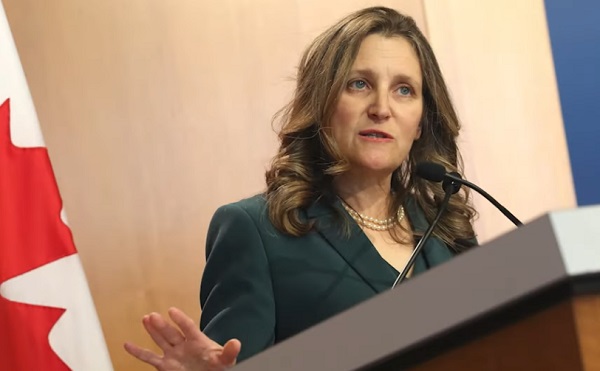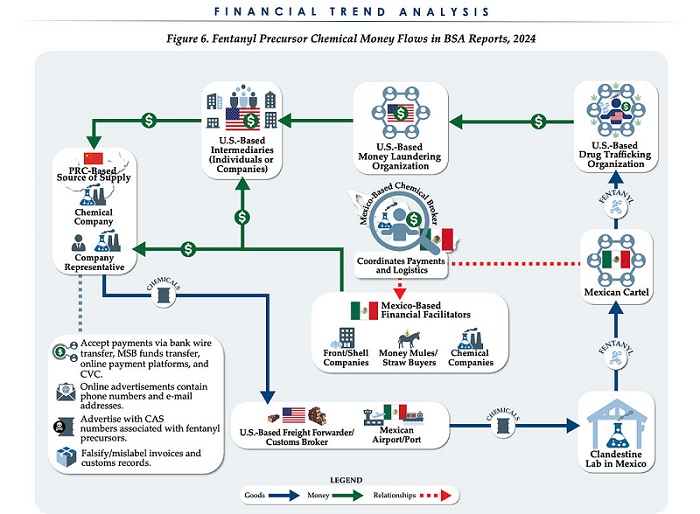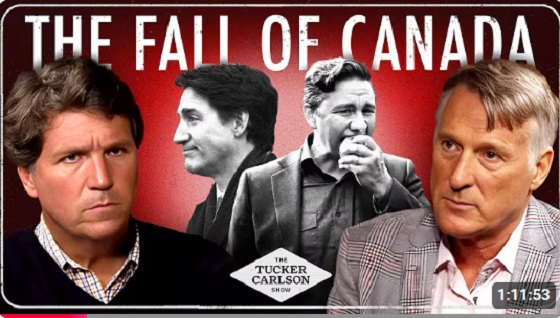National
Chrystia Freeland apparently was told last Friday via Zoom call that Canada’s prime minister had lost confidence in her and she was being replaced by Mark Carney

From LifeSiteNews
Former finance minister learned of Trudeau’s decision to replace her before she quit: report
Prime Minister Justin Trudeau was planning to replace now-former Minister of Finance Chrystia Freeland with globalist-linked former central banker Mark Carney, according to insiders.
At least two inside sources, as reported by the Globe and Mail, said Freeland, who quit as finance minister Monday, learned on a Zoom call last Friday from Trudeau that Carney, the former Bank of Canada and Bank of England governor, would take over her job.
The sources noted that Trudeau told Freeland he had lost confidence in her and the job was going to Carney. She was to be offered another role but considered it a demotion. However, Carney did not accept the job offer from Trudeau after Freeland resigned Monday, sources indicated.
According to the sources who remain confidential, it is not clear whether Carney had accepted a job offer to join the Trudeau government. However, sources close to the former head banker said he did not want to be a part of the government.
The move to replace Freeland with an unelected MP such as Carney would have been highly unusual.
Freeland on Monday sent shockwaves through Canada’s political circles after she announced her resignation from the Liberal cabinet, revealing that she did so after Trudeau asked her to step down as finance minister and move into a different position.
Her public resignation letter blasted Trudeau’s economic direction and apparent lack of willingness to work as a team player with the nation’s premiers.
Calls for Trudeau to resign intensified after Freeland stepped down.
The most recent polls show a Conservative government under its leader Pierre Poilievre would win a super majority were an election held today.
As for Carney, as reported by LifeSiteNews, in October, rumors began to swirl that Carney had again hinted he was planning on diving into Canadian politics amid demands that Trudeau step down as PM.
Carney has close ties in working with the World Economic Forum (WEF) on many files. He also supports globalist-backed energy regulations such as Canada’s punitive carbon tax.
As noted by LifeSiteNews, Carney may be even more extreme than Trudeau on the carbon tax after he rebuked the prime minister for exempting home heating oil from the carbon tax in some provinces.
Carney works for Brookfield Asset Management and the United Nations special envoy on climate action.
Critics say the World Economic Forum is behind the socialist “Great Reset” agenda of which Trudeau and some of his cabinet, including Freeland, are involved.
Freeland’s resignation not only sent shockwaves through Ottawa’s political circles but drew the attention of U.S. President-elect Donald Trump. Earlier this week, he did not hold back in celebrating her departure, saying the “toxic” second-in-command will “not be missed.”
2025 Federal Election
Poilievre will cancel Mark Carney’s new Liberal packaging law and scrap the Liberal plastic ban!

From Conservative Party Communications
Conservative Leader Pierre Poilievre promised today that a new Conservative government will stop Mark Carney’s proposed Liberal food tax and scrap the existing Liberal plastic ban. Poilievre will:
- Stop proposed new labelling and packaging requirements that will raise the cost of fresh produce by as much as 34% and cost the average Canadian household an additional $400 each year.
- Scrap the Liberal plastics ban, including the ban on straws, grocery bags, food containers and cutlery, and other single-use plastics, letting consumers and businesses choose what works for them.
- Protect restaurants, grocers, and low-income Canadians from one-size-fits-all packaging rules that disproportionately affect those who can least afford it.
“After the Lost Liberal Decade, many Canadians can barely afford to put food on the table. And now Mark Carney and the Liberals want to make it even harder with a new food packaging law that will raise the price of food–again,” said Poilievre. “A new Conservative government will keep food prices down by scrapping the Liberal plastic ban and stopping Carney’s new Liberal food tax.”
After a decade of out-of-control spending and massive tax increases, families are spending $800 more on food this year than they did in 2024, and food banks had to handle a record two million visits in a single month. In Montreal, 44 percent of CEGEP students are experiencing some form of food insecurity, while places like Hawkesbury, Kingston, Toronto and Mississauga have all declared food insecurity emergencies.
And food prices are still rocketing upwards, surging by 3.2% over the last year, with no end in sight. In the last month alone, food inflation increased by 1.9 percentage points—the largest monthly jump in food prices in decades.
As if this wasn’t bad enough, Liberals have made life even more expensive and inconvenient for Canadians by banning plastics – including everything from straws to bags to food packaging. The current Liberal ban on single-use plastics will cost Canadians $1.3 billion dollars over the next decade.

Now Mark Carney wants to make it worse by adding complicated and costly new food packaging rules that will drive up the price of food even more–in effect, a new Liberal food tax. Plastic food packaging makes up 1/3 of all plastic packaging in Canada. The proposed Liberal food tax will cost the average Canadian household an additional $400 each year, waste half a million tonnes of food, decrease access to imported fruit and produce, and increase food inflation. The Chemistry Industry Association of Canada has also warned that this tax will put up to 60,000 Canadians out of work.
“The Liberals’ ideological crusade against convenience has already driven up food prices and the last thing Canadians need is Mark Carney’s new food tax added directly to your grocery bill,” said Poilievre. “The choice for Canadians is clear, a fourth Liberal term that will make food even more expensive or a new Conservative government that will axe the food tax and bring back straws, grocery bags and other items, to make life more affordable and convenient for Canadians – For a Change.”
2025 Federal Election
PRC-Linked Disinformation Claims Conservatives Threaten Chinese Diaspora Interests, Take Aim at PM Carney’s Debate Remark

As polls tighten in Canada’s pivotal federal election, a Chinese-language website has published multiple editorials suggesting that a Pierre Poilievre government could threaten Chinese Canadian interests with so-called “anti-China” policy clauses—claiming it could bring “inconvenience to the lives of Chinese people, such as restrictions on the use of social media, reductions in return air tickets, etc.”
During the 2021 federal election, then-Conservative leader Erin O’Toole and MP Kenny Chiu were widely attacked with similar arguments across Chinese-language news and social media. CSIS reporting from 2022, cited exclusively by The Bureau, warned that Chinese-language media in Canada is effectively controlled by Beijing and weaponized during election periods to spread Chinese Communist Party-aligned narratives.
One of the new articles also criticizes Prime Minister Mark Carney’s debate remark that Beijing poses the greatest threat to Canada’s national security—a comment that prompted the Chinese-language editorial to question whether Carney’s statement was “a gimmick to attract attention.”
The articles, published Thursday and Friday by 51.ca, have raised deep concern among some community members. One longtime Chinese Canadian journalist, who requested anonymity due to fear of retaliation, told The Bureau they were alarmed by the messaging and suspected the coverage was driven by election-interference motives.
One of the pieces claimed that “the Conservative Party has written anti-China clauses into the party platform,” referencing a prior story that quickly circulated on Chinese-language social media and triggered fearful discussion.
Citing WeChat commentary on the same article, the journalist pointed specifically to a politically connected figure previously associated with CSIS investigations into election interference networks in the Greater Toronto Area—allegedly tied to clandestine funding channels linked to the Chinese Consulate in Toronto.
Sharing a WeChat forum screen-picture, the diaspora journalist noted:
“The writer said, according to the Conservative’s campaign platform, China’s definition is ‘enemy.’ So what is the impact on Chinese Canadians’ daily life? Facing more discrimination? Fewer flights going back to China? How about using social media? If there is a war, what will happen to Chinese Canadians—like Japanese people were sent to the concentration camps or deported?”
The journalist said the messaging is not only inflammatory, but dangerously manipulative—casting the Conservative Party as a threat to the civil rights and safety of Chinese Canadians, while exploiting historical trauma to provoke fear.
The same 51.ca article—while quoting from the Conservative Party’s platform documents—shifts sharply into misleading commentary. It contrasts the party’s current positions with historical discrimination enacted by the Liberal government of the 1920s.
One of the recent 51.ca articles warns that the Conservative Party’s stance “can easily cause ethnic tensions and even exacerbate anti-China sentiment.”
A second article delivers a similar critique of Conservative policy while also taking aim at Prime Minister Mark Carney, who, in last night’s nationally televised debate, stated:
“I think the biggest security threat to Canada is China.”
That comment, consistent with assessments from Canadian intelligence services and allied Five Eyes partners, was immediately seized upon by 51.ca’s editorial board.
“Carney blurted out that China is Canada’s biggest threat. Is this a deep-rooted idea or a gimmick to attract attention? It is not known yet. But what is certain is that when other party leaders are talking about how to deal with the problems facing Canada itself, Carney is talking about China being the enemy. I really don’t know what’s going on in his mind.”
Both 51.ca articles strategically focus their sharpest criticism on the Conservative Party, portraying its platform as existentially dangerous, while the second treats Carney’s one-line debate comment as a moment of rhetorical overreach.
The Bureau is a reader-supported publication.
To receive new posts and support my work, consider becoming a free or paid subscriber.
Invite your friends and earn rewards
-

 Business1 day ago
Business1 day agoChina, Mexico, Canada Flagged in $1.4 Billion Fentanyl Trade by U.S. Financial Watchdog
-

 2025 Federal Election2 days ago
2025 Federal Election2 days agoTucker Carlson Interviews Maxime Bernier: Trump’s Tariffs, Mass Immigration, and the Oncoming Canadian Revolution
-

 Business2 days ago
Business2 days agoDOGE Is Ending The ‘Eternal Life’ Of Government
-

 espionage2 days ago
espionage2 days agoEx-NYPD Cop Jailed in Beijing’s Transnational Repatriation Plot, Canada Remains Soft Target
-

 2025 Federal Election2 days ago
2025 Federal Election2 days agoCanada drops retaliatory tariffs on automakers, pauses other tariffs
-

 2025 Federal Election1 day ago
2025 Federal Election1 day agoBREAKING from THE BUREAU: Pro-Beijing Group That Pushed Erin O’Toole’s Exit Warns Chinese Canadians to “Vote Carefully”
-

 Daily Caller1 day ago
Daily Caller1 day agoTrump Executive Orders ensure ‘Beautiful Clean’ Affordable Coal will continue to bolster US energy grid
-

 Daily Caller1 day ago
Daily Caller1 day agoDOJ Releases Dossier Of Deported Maryland Man’s Alleged MS-13 Gang Ties







